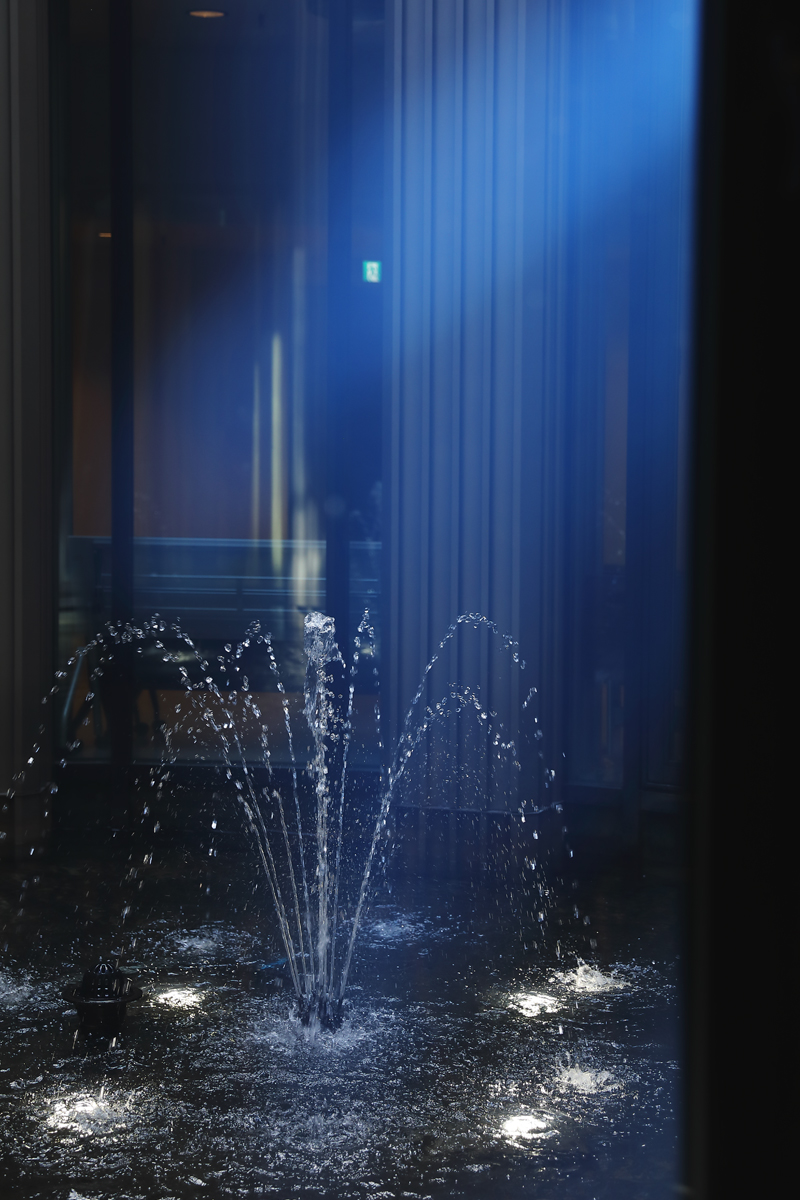和と洋が融合した、迎賓の空間。
Feature | 2024.05.23
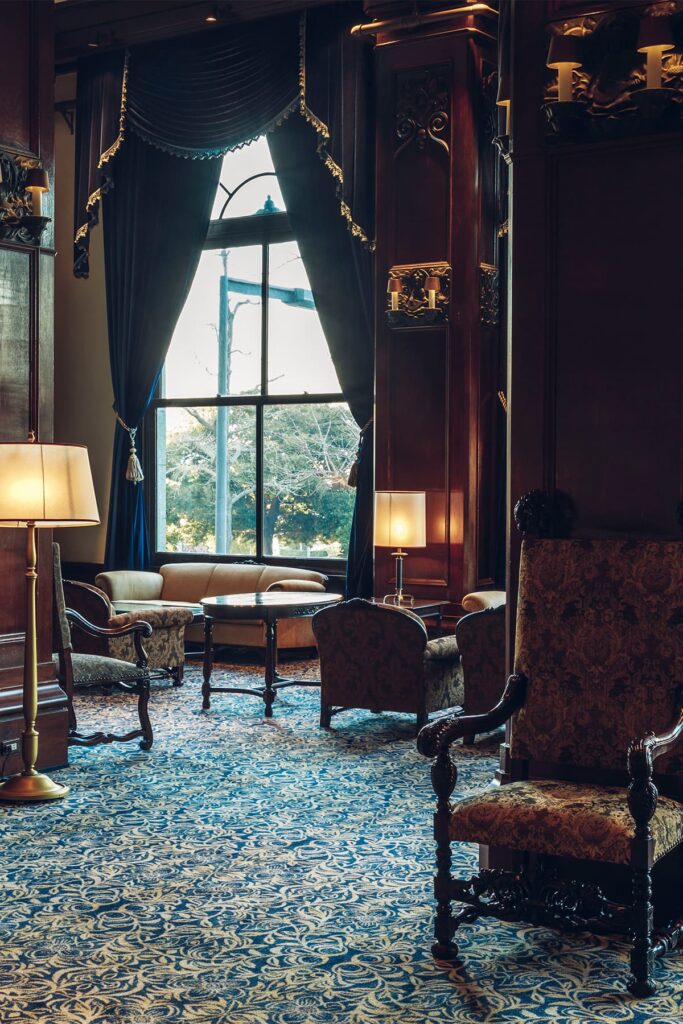
横浜のクラシックホテルといえばホテルニューグランド。
多くの著名人に愛された歴史ある建造物には、旅人を上質にもてなす迎賓の空間があった。
“おもてなし”といえば、横浜。なんといっても、この地の“おもてなし”には歴史と多くのストーリーがある。日米和親条約締結後、1859年に開港された横浜はそこから、日本を代表する貿易都市として海外からたくさんの人々が訪れるようになる。まだ外国人が珍しい時代、横浜の人たちは試行錯誤しながら、日本流の“おもてなし”で、海を超えてやって来た客人をお迎えしたことだろう。
旅人をもてなすとき、肝心になるのが宿泊施設。長い船旅で疲れたカラダをゆっくりと休めてもらい、さらに日本という異国を楽しんでいただく。そのための、最上のおもてなしの場となったホテルがホテルニューグランドだった。
ホテルニューグランドは1927年、関東大震災から立ち上がろうとしていた横浜を象徴する存在として誕生。当初は喜劇王のチャップリンや野球選手のベーブルースといった海外からの錚々たる賓客たちが宿泊。第2次世界大戦後はGHQによって接収され、マッカーサー元帥も逗留した。その後、1952年に営業を再開。日本が高度成長期を迎え豊かになってきた頃から日本人も盛んに利用するようになった。横浜のラグジュアリーなイメージを具現化することで、多くの財界人や芸能人にも愛されてきたホテルニューグランドは、バーがサザンオールスターズの歌にもでてくるなどで、現代では若い人たちの憧れのホテルにもなっている。
クラシカルな本館に隣接して近代的なタワー館が完成したのが1991年。そして2004年には本館の客室を、2007年には本館ロビーをリニューアル。ただし、リニューアルといっても、すべてを真新しくするような野暮なことはしない。独自の設計・意匠や家具のひとつひとつに気を配り、オープン当時のものはなるべくそのままにしながら、時代の積み重なりが体感できる、クラシカルでモダンな空間をつくりあげた。
ホテルニューグランドの建築としての見所が詰まっているのが本館2階ザ・ロビー。この歴史的な空間はさまざまな発見にあふれている。
A welcoming space where Japanese and Western aesthetics merge.
Yokohama boast a long and storied history of hospitality. Following the Treaty of Kanagawa, it opened its port in 1859, becoming a major trading hub and attracting numerous visitors from abroad. In an era when foreigners were still rare, the people of Yokohama, through trial and error, extended traditional Japanese hospitality to these guests.
Accommodations play a crucial role in hospitality. After lengthy sea voyages, travelers needed a place to rest and experience Japan’s exotic charm. The Hotel New Grand became the epitome of superlative hospitality.
Founded in 1927, the hotel emerged as a symbol of Yokohama’s quest to recover from the Great Kanto Earthquake. Early on, it hosted distinguished foreign guests like Charlie Chaplin, the king of comedy, and baseball legend Babe Ruth. Post-World War II, the hotel was requisitioned by the GHQ, and notably hosted General MacArthur.
After reopening in 1952 during Japan’s rapid economic growth, the hotel saw an increase in Japanese guests. Embodying Yokohama’s image of luxury, it became favored by business leaders and celebrities, and even featured in a song by Southern All Stars, becoming popular even among young people today.
In 1991, a modern tower wing was added alongside the classical main building. Renovations in 2004 and 2007 updated the guest rooms and lobby, respectively, with care taken to preserve the original character as much as possible, creating a space that is both classical and modern and allowing visitors to feel the layers of time.
A key architectural feature of the Hotel New Grand is the grand staircase leading to the second-floor lobby of the main building, a space rich with historical discoveries.
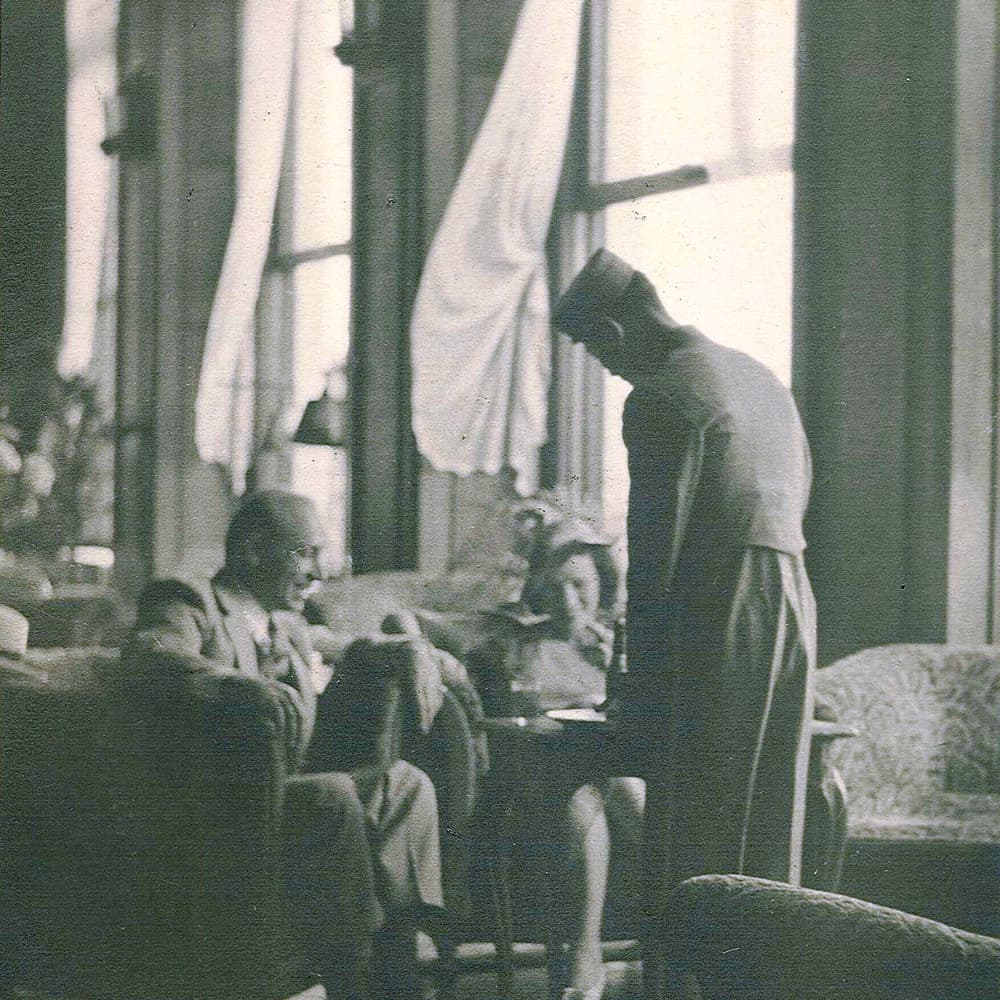


クラシックな家具が置かれた2階ザ・ロビー。
宴会場が使用されているときは立ち入ることができないのでご注意を。

HOTEL NEW GRAND
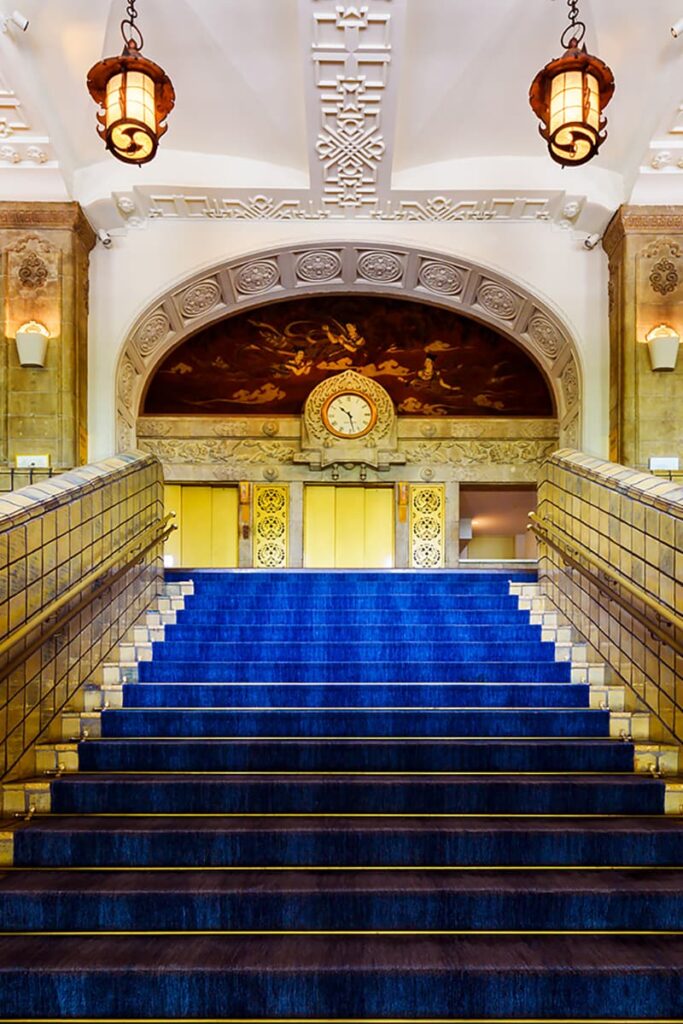
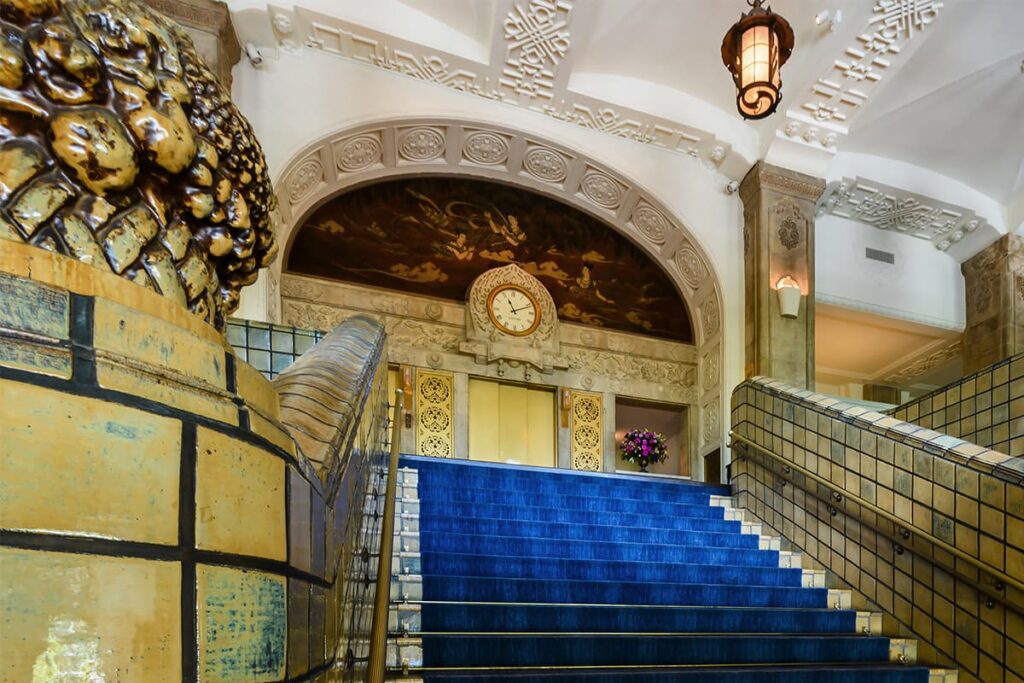
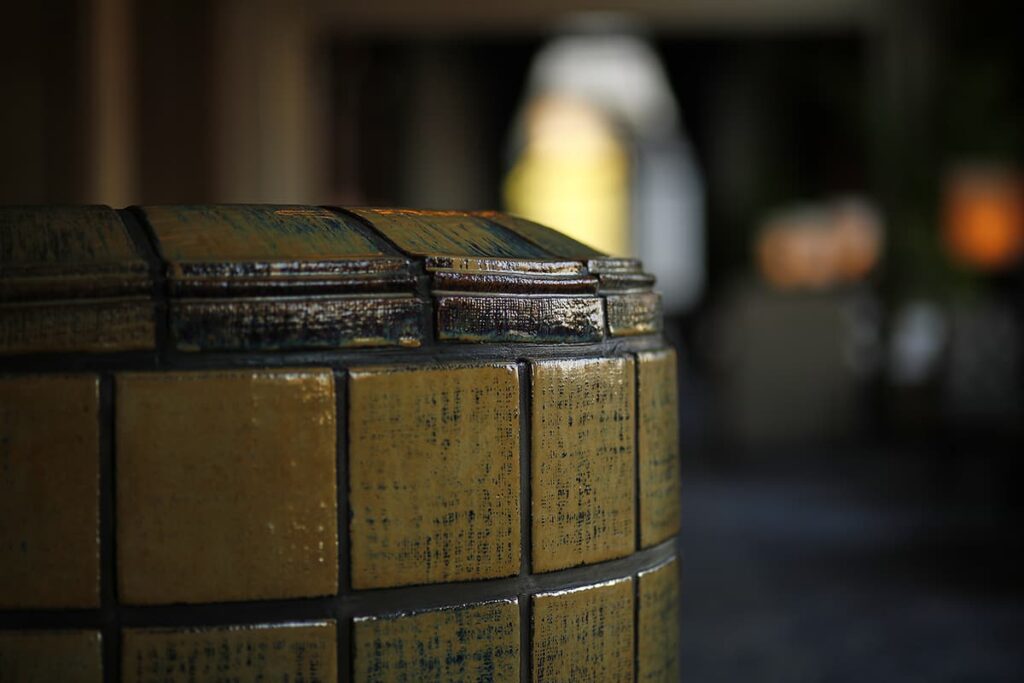

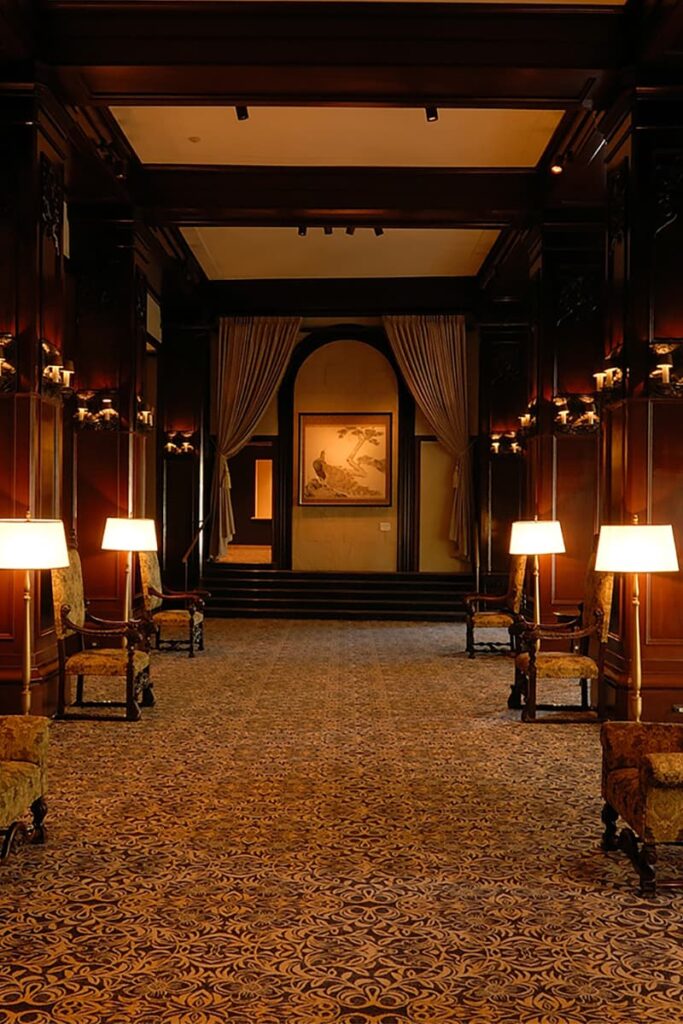
a.大階段(ホテルニューグランドのシンボル的存在の大階段。ニューグランドブルーと呼ばれる青い絨毯が敷かれている。)
b.本館ザ・ロビー
c.本館ザ・ロビー
ディテールに目を凝らせば、和とアジアが浮かび上がる。
「神は細部に宿る」といったのはドイツのモダニズム建築家ミース・ファンデル・ローエ。その言葉はここ、ホテルニューグランドにもあてはまる。
ホテルニューグランド本館の外観を眺め、中へと一歩入れば、ヨーロッパ調のクラシカルな印象を受ける。古くからここに海外の人たちが出入りしていたことが実感できる、ロマンにあふれた場所だ。
本館に入るとまず、階段がある。ホテルニューグランドのシンボル的存在の大階段だ。 そのまま2階ザ・ロビーへと急いではいけない。この階段をじっくり眺めると、両サイドにフルーツバスケットのオブジェがあるのに気づく。 これは海外のホテルによくあるウエルカムフルーツで、おもてなしの心があらわされている。手摺りのタイルも味がある。イタリア製の手焼きのタイルで一枚一枚、特注されたもの。使用される部分に合わせて湾曲したものや菱形のものなど、さまざまなバリエーションがある。 青みを帯びた美しい色合い。 つるんとしていたり、ちょっとざらつきがあったり、触感もそれぞれ違い、手で触れたときの多彩な味わいが楽しめる。
階段を上がりながら天井へと視線を移すと、そこにあるのは天女奏楽の図が織られたタペストリー。 ん?! ヨーロッパなイメージのホテルニューグランド、なのに天女? さらにタペストリー近くのアーチのなかにもやはり、和風の紋様がある。天井から下がっている照明も和のテイスト。和紙でできていて、僧侶が修行する伽藍にあるようなデザインになっている。
こうして細かく見ていくと、いくつもの日本や東洋が設えてある。しかもそのどれもが、手の込んだもの。海外からの宿泊客は、そんなところを発見することで、エキゾチックな魅力を感じたことだろう。これもひとつの“おもてなし”。ホテルニューグランド本館の空間、その細部には迎賓の心が宿っている。
Japanese and Asian influences emerge from the details.
“God is in the details,” said the German modernist architect Mies van der Rohe, words that apply well to the Hotel New Grand.
Observing the main building’s exterior and stepping inside, one is struck by its classical European style. The place is filled with romance and one can sense the traffic of people from overseas since olden times.
Upon entering the main building, you are greeted by the grand staircase, an iconic symbol of the Hotel New Grand. Take a moment to appreciate its beauty rather than hurrying to the second-floor lobby. Each side of the staircase features a fruit basket sculpture on each side, a nod to the welcome fruits commonly found in international hotels, symbolizing hospitality. The handrails are adorned with hand-fired Italian tiles, custom-made in various shapes, some curved, others diamond-shaped, each carefully placed and uniquely textured, contributing to the overall aesthetic with their beautiful bluish hues.
As you ascend the stairs and look up to the ceiling, you will see tapestries with scenes of oriental celestial maidens playing music, a surprise in this European-style hotel. The arches by the tapestries also feature Japanese-style motifs. The hanging lights, made of washi paper and designed after those found in Buddhist monasteries, also have Japanese flair.
Thus looking closely, you will come upon various Japanese and Eastern elements, each meticulously crafted. A great many foreign guests likely have felt the exotic charm of this place. The main building of the Hotel New Grand is thus infused with a welcoming spirit visible in its details.

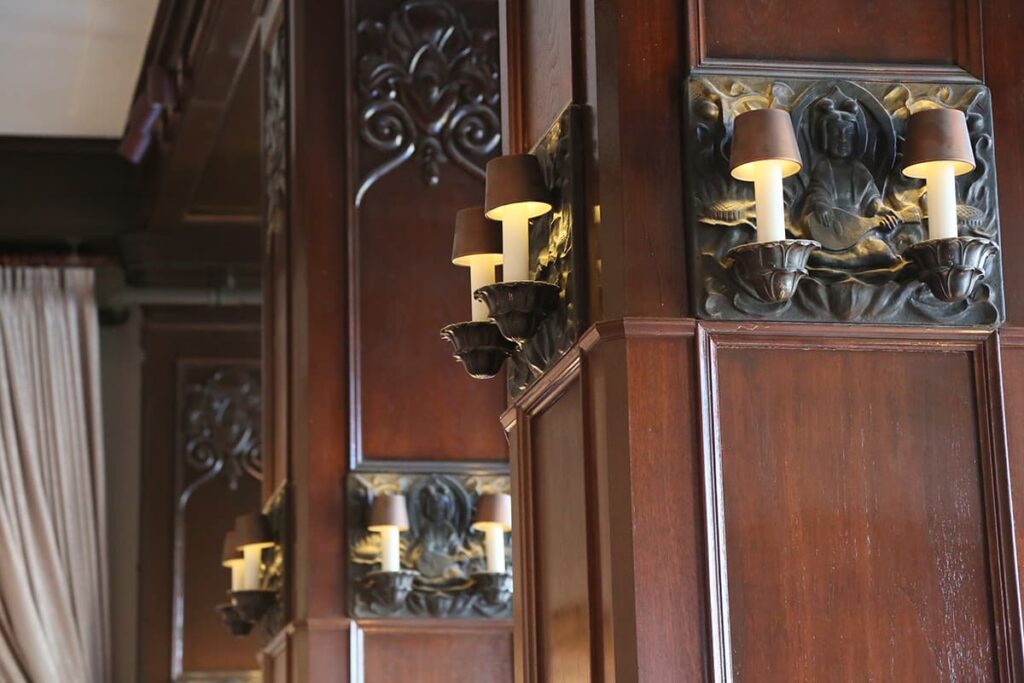

a.天使の肘掛け
エキゾチックな魅力が旅情をかきたてる。
ホテルニューグランド本館を設計したのは、国立博物館や銀座の和光を手がけた渡辺仁。渡辺が大切にしたのは横浜の旅情を感じてもらうことで、その想いは本館2階ザ・ロビーに表現されている。
大階段を上がると、そこは約5mの天井高をもつスケールある空間。大きな窓が連なり、銀杏並木とその向こうにある海の碧を室内に呼び込んでいる。ここに座り、ぼんやりと窓外を眺めていると、時が止まり、旅路にある情緒に心が奪われる。自分がいま、横浜にいることの歓びが感じられる空間だ。
素晴らしいのは空間だけではない。 そこに置かれている家具は「横浜家具」という希少なもの。 その昔、横浜に住んでいた外国人が、自分たちが使っている洋家具の修理を横浜の家具職人に依頼した。そうするうちに家具職人たちは洋家具がもつ曲線や装飾の美しさを知り、 その造りなどをおぼえ、やがて自分たちで洋家具を造作するようになる。 それが「横浜家具」と呼ばれ、いまでは価値あるものになっている。
ここに置かれている家具のなかでも、ひときわ存在感を放っているのがキングスチェアと呼ばれるイス。その威風堂々としたデザインは、まさに王の風格。肘掛けには勝利の女神であるニケの装飾が施されていて、撫でると幸運が訪れるという噂も。製造された当時、高級車一台分ほどの価格がついていたというこのイスに、いまでは誰でも気軽に腰掛けることができる。
そしてこの空間にもまた、日本やアジアのテイストがちりばめられている。マホガニーの柱の上には弁財天を描いた燭台があり、壁面にはインドの聖典であるカーマスートラのレリーフ、天井から吊り下げられた照明には巴紋がある。和と洋が高い次元で調和し、ここを独特な空間に仕上げている。
海外からの旅行客は日本やアジアのテイストに心が躍り、 日本の旅行客はヨーロピアンな雰囲気にうっとりとする。 和洋折衷な設えで旅情をかきたて、旅人を上質にもてなす空間。 ホテルニューグランドには迎賓の心が息づいている。
Exotic charm that stirs the hearts of travelers.
The main building of the Hotel New Grand was designed by Jin Watanabe, known for his work on the National Museum and the Wako building in Ginza. Watanabe aimed to capture Yokohama’s spirit of travel, a theme that resonates throughout the second-floor lobby.
Ascending the grand staircase, you enter a spacious area with a ceiling height of about 5 meters, featuring large windows that overlook a ginkgo tree-lined avenue and the blue sea beyond. Here, time seems to pause, immersing visitors in the emotional depth of their journey. This is a space where one can truly savor the joy of being in Yokohama.
The splendor extends to the furniture, a rare kind known as “Yokohama furniture.” Historically, foreigners living in Yokohama had their Western furniture repaired by local craftsmen, who became acquainted with the beautiful curves and decorations of Western furniture, learned its construction, and eventually started making their own pieces. Yokohama furniture is now quite valuable.
Among the furniture, the chair known as the King’s Chair stands out with its regal presence and presence fit for royalty. Adorned with symbols of Nike, the goddess of victory, its armrests are rumored to bring good luck to those who touch them. Although the chair originally cost as much as a luxury car, now anyone can casually sit on it.
This space is also sprinkled with Japanese and Asian touches. The mahogany pillars are topped with candleholders depicting Benzaiten, the walls feature Kama Sutra reliefs, and the hanging lights bear the tomoe crest. The high level of harmony between the Japanese and Western elements makes this a unique space.
Travelers from abroad are thrilled by the Japanese and Asian elements, while Japanese visitors are drawn to the European ambiance. This eclectic mix of design elements ignites wanderlust and offers refined hospitality, embodying the Hotel New Grand’s welcoming spirit to all guests.


※画像は2名様分のイメージです
色鮮やかなティーフーズが夏の思い出を彩る
サマーアフタヌーンティー
2024年7月1日(月)~8月31日(土)
料金 ¥6,704(税込・サービス料込)
<土日祝はご利用時間を3時間とさせていただきます>
提供店舗 本館1階 ロビーラウンジ ラ・テラス
https://www.hotel-newgrand.co.jp/la-terrasse/

閲覧中の特集はこちら
